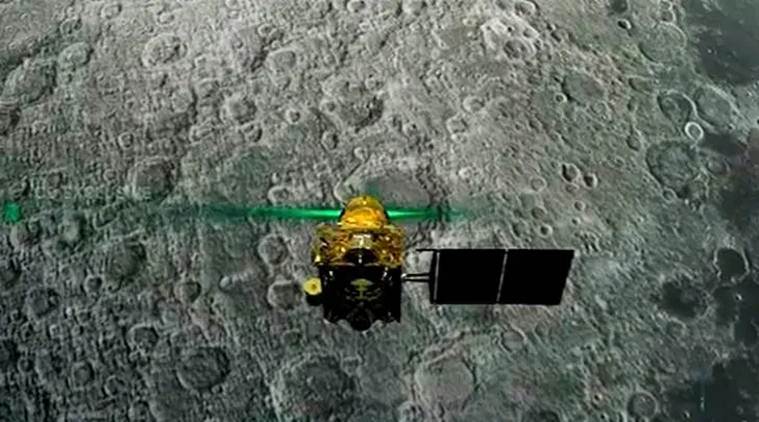- India
- International
Chandrayaan-2: Vikram lander spun out of control midway to landing site, ISRO could only watch
With the communication system on the failed lander supplying data on its performance right up to 400 metres before crashing on the surface of the moon, ISRO is now confident that the errors that occurred will be corrected during Chandrayaan-3, which has been cleared for launch in 14-16 months.
 The Indian Space Research Organisation’s maiden attempt at a soft landing on the moon failed on September 7, 2019, as it lost contact with the lander during its controlled descent.
The Indian Space Research Organisation’s maiden attempt at a soft landing on the moon failed on September 7, 2019, as it lost contact with the lander during its controlled descent.
The Chandrayaan-2’s Vikram lander ended up spinning over 410 degrees, deviating from a calibrated spin of 55 degrees, and making a hard landing on the moon, according to ISRO scientists. The anomaly, which occurred during the second of four phases of the landing process, was reflected in the computer systems in the mission control room, but ISRO scientists could not intervene to correct it as the lander was on autonomous mode, using data already fed into its system before the start of the powered descent.
The Indian Space Research Organisation’s maiden attempt at a soft landing on the moon failed on September 7, 2019, as it lost contact with the lander during its controlled descent.
Read | To the moon and back
With the communication system on the failed lander supplying data on its performance right up to 400 metres before crashing on the surface of the moon, ISRO is now confident that the errors that occurred will be corrected during Chandrayaan-3, which has been cleared for launch in 14-16 months.
“There is a lot of data that we have been able to get from the analysis of the hard-landing of the Vikram lander, since data is available right upto 400 metres before the landing. This data is valuable for ensuring the success of the next mission,’’ said a senior ISRO scientist.
On January 1, in his first official statement on what caused the hard landing, ISRO Chairman K Sivan said it was the result of a less than optimal reduction in velocity of the lander during a second “camera coasting phase’’ for the soft landing.

Also read | ISRO working simultaneously on Chandrayaan-3 and Gaganyaan
“What really happened in Chandrayaan-2 was that in the powered descent phase. which contained four phases. everything went alright in the first rough braking phase, which is the major phase. In the second phase, which was the ‘camera coasting phase’, the velocity was not reduced to the amount it was supposed to be reduced, and so velocity was more than required,’’ Sivan said.
“The next ‘fine braking phase’ was not able to handle the large velocity… the velocity was beyond the designed limit of the navigation guidance and control system; it could not take care of the system and it finally ended up in a hard landing,’’ said Sivan.
The Vikram lander was equipped with five thrusters to regulate its landing process. Earlier, Minister of State in the Prime Minister’s Office Jitendra Singh had said, in a reply to a question in Lok Sabha, that a malfunction in the second phase of the landing had caused the hard landing.
“The first phase of descent was performed nominally from an altitude of 30 km to 7.4 km above the moon surface. The velocity was reduced from 1683 m/s to 146 m/s. During the second phase of descent, the reduction in velocity was more than the designed value. Due to this deviation, the initial conditions at the start of the fine braking phase were beyond the designed parameters. As a result, Vikram hard-landed within 500 m of the designated landing site,’’ he had said.
In September 2019, ISRO had said the lander “followed the planned descent trajectory from its orbit of 35 km to just below 2 km above the surface. All the systems and sensors of the lander functioned excellently until this point and proved many new technologies such as variable thrust propulsion technology used in the lander.’’
The frozen screens at the Chandrayaan mission control had, on September 7, 2019, shown that communication was lost when the lander was barely 335 metres from the surface of the moon, moving with a vertical velocity of 59 metres/sec or 212 km/hr and a horizontal velocity of 48.1 m/sec or 173 km/hr, around 1.09 km from the designated landing spot.
As per the original plan, the Vikram lander should have lost most of its velocity when it was 400 metres away from the moon’s surface, and should have been hovering over the intended landing site, but the data frozen at the mission control indicates it was still moving at speed despite crossing the threshold for a soft vertical descent at a “walking pace’’.
The 15-minute process of reducing the velocity of the Vikram lander from 1680 m/sec (about 6000 km/hr) to 0 m/sec to enable a soft landing was into its 12th minute when the screens at the mission control froze, with messages on the giant screens indicating loss of communication with the lander.
ISRO has now begun working on Chandrayaan-3, with the errors that occurred in the Chandrayaan-2 landing process identified and ready to be corrected. “The data we have got from Chandrayaan-2 mission, including the failed landing, is invaluable. Nobody will provide this kind of data for a space mission. It has been a great learning experience,’’ an ISRO scientist said.
“The activity on Chandrayaan-3 is going on very smoothly. The configuration of Chandrayaan-3 will be almost similar to Chandrayaan-2. The only difference is that in Chandrayaan-2, we had orbiter, lander and rover configuration. In Chandrayaan-3, the orbiter that is already functional from the Chandrayaan-2 project will be used. Chandrayaan-3 will have a lander and rover with a propulsion module. We have initiated this project,’’ Sivan said last week.
The cost of Chandrayaan-2 was Rs 978 crore (Rs 603 crore for the spacecraft, Rs 375 crore for the GSLV Mk III rocket launcher) while the cost of Chandrayaan-3 mission is estimated at Rs 250 crore.
More Tech
Must Read
Apr 20: Latest News
- 01
- 02
- 03
- 04
- 05








































